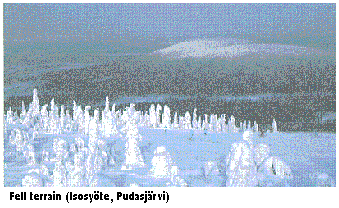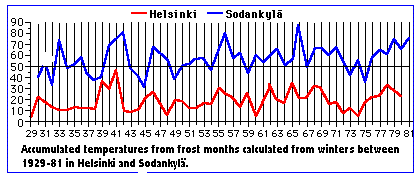To the main menu
THE WINTER OF OUR NORTHERN NATURE


|
|
|
|
|
Sorry, only "1. Environmental factors" and "4. The hard midwinter" are translated into English!
Despite some links in winter-part are not as yet working!
|
|
|
|
|
|
|
|
1. Environmental factors:
You are now in the part dealing with the temperature conditions in the winter.
Other topics on winter
Other topics concerning nature: Main menu!
See also:

1. Enviromental factors: temperature
Finnish winter is quite mild...
Finland is far away in the North, not in the
arctic, but in the cool temperature climatic zone (snow forest
climate). Elsewhere at the same latitudes there is an arctic
climate. More: Winter temperatures! See also: Our northern nature/general!
January in Finland is 10 - 12° C warmer than
almost anywhere else at the same latitudes.
In the continental climate zone areas of Siberia the winter is in
places even 30 degrees colder than in Finland. Cold winters
can still be fatal among others to some of our birds!.
Severe frosts (annual minimum -20°) only take
place on about 40 percent of the earth's whole area. Only in third
of the earth's area there are no severe frosts at all.
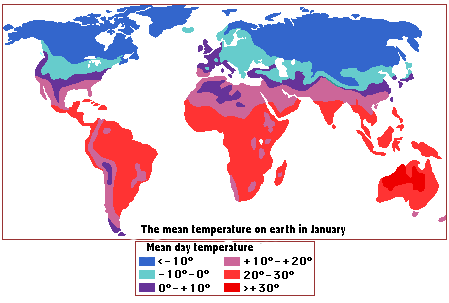
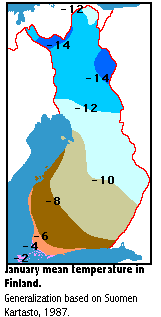
The Finnish climate is not very continental or
very maritime. See also: Mean temperature annual variation!
Weather conditions vary a lot especially
in the western part of Europe (also in Finland).
With the help of
accumulated temperature sum, winter's frost accumulation can
be measured. Summer's warmth is measured similarly.
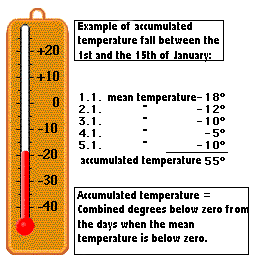
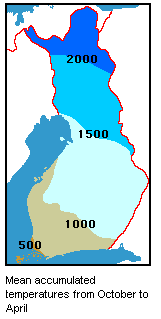
In Northern Finland the frost sum accumulation in the air (2 meters
high) during the winter is approximately 1500- 2000 degrees.
Because of our snowy and long winter the climate in Finland is often called a snow forest climate. Mild weather makes it possible for forests to exist almost in the whole country. See also: Snow forest climate!
Almost all of Finland's vegetation belongs to the area of
boreal coniferous zone, when most of
Central Europe is mainly temperate deciduous forest zone.
Thermal winter begins when the accumulated temperature is fixed
(at least for a week) below 0° C. In Lapland, it begins already in
mid October, in Southern Finland over a month later. See also:
Thermal winter!
Thermal winter ends in Lapland between April and May and in Southern
Finland in the beginning of April.
Thermal winter lasts in Northern Finland even 6 -7 months but in
Southern Finland only 3 - 4 months.
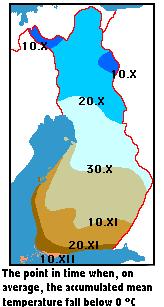
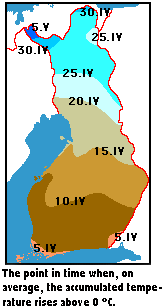
Pictures above: On the left winter begins/autumn ends. On the
right winter ends/spring begins
Winter temperatures vary from year to year
At Finland's latitudes weather changes greatly:
sometimes the winter is very cold and sometimes it is very mild.
After Ice Age there have been many different kinds
of climates. Especially mild winters have been, among others, those
of: 1924 - 25, 1929 - 30 and 1933 - 34. All of the 1930 has been
called a warm season. Winters were then 2 - 3 degrees
warmer than at the beginning of the century. After that it has been
colder. Cold winters have been, among others, winters in: 1939 - 44
and 1960 and also the Januarys in 1985 and 1987.
Topography clearly makes its mark on temperatures
The seas have a major effect on winter climate. In
the wintertime they work as a source of heat, and balance the
temperature changes. The proximity of warm Gulf Stream is the
most important reason for the mildness of our climate. In the coast
of Norway the streams effect can be seen even more clearly. For
example, January's mean temperature is in Bergen (which is in the
coast of Norway) 0°, in Helsinki -6.1° C and in Jakutia (Siberia)
-45 - 59° C. However, all of these places are located almost at the
same latitude. In Jakutia, the climate is very continental and in
the winter the so-called inversion often takes place.
Inversion = cold air flows down, the warm layer is higher. In the winter, it can be several degrees warmer in the upper slopes of the fells than in the valleys. In the summer time, the situation is reverse. See also: Inversion!
In the mountain ranges the mean
temperature falls here in the North about half degrees for every
climbed 100 meters. Through the year, there is a permanent snow
cover, for example, in Norway up from 0.8 - 1.9 kilometers, in
the Alps from 2.4 - 3.2 kilometers high and in the equator up from
about 5 kilometers.
